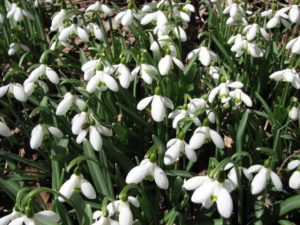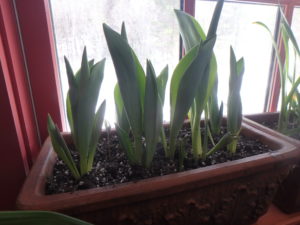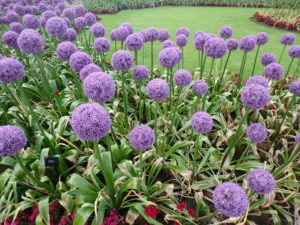Gardening: The Slowest of the Performing Arts
March has been ferocious. None of this “In like a lion, out like a lamb” business. The entire month has been a Tyrannosaurus Rex, if you ask me. I’ve done more roof-shoveling this month than I usually do in a year. My poor snowdrops, usually showing me their noses in early March, are still deep in snow. Sigh. But spring will come. It always does.
Snowdrops, my harbinger of spring, are best planted on a south-facing hillside. That way the snow melts off early, and allows them to push up through the frozen soil. Unlike tulips, their little white flowers look downward, so one must bend over and tip the blossoms up to see inside, which is always the most interesting view of a flower – all those stamens and pistils.
My snowdrops have multiplied over the decades. I don’t know if they move by seed, or if little rodents dig them up and move them around. I suspect it is by seed since they tend to move downhill into the lawn. Fortunately, they get all the sunshine they need to re-charge their batteries by the time I’m ready to mow the lawn. Daffodil leaves, on the other hand, don’t dry up until July, so I don’t plant them in the lawn.
Glory of the snow (Chionodaxa lucilae) is another small early bulb plant that will appear as soon as my snow disappears, and it has multiplied nicely over the years, too. I have it light blue, white and pink. Unlike snowdrops, the blossoms open with their faces up towards the sun – and us.
Scilla siberica, or squill, comes out just a few days after my glory of the snow and has a very intense purple color. Just a couple of inches tall, these small beauties look down, like the snowdrops. These do not multiply quickly, though their clumps or clusters do get more robust over time.
Bright yellow, school bus yellow, I associate with daffodils, and I have plenty of those that bloom in April and May. But before even the earliest are some short yellow blossoms of winter aconite (Eranthis hyemalis). I just learned that they are related to buttercups, which makes sense to me, given their color and flower shape.
Aconite are marginally hardy for me in Zone 4, but last spring I had many tiny ones, clearly first-year plants that developed from seed. I wonder if they will return and bloom for me this year. Such questions will get me outside and in the garden every day, should I ever get old and frail.
Many gardeners have given up on tulips because they are so tasty: to rodents that eat the bulbs, and to deer that consume the buds, blossoms and leaves. Not only that, most gardeners find tulips don’t return, year after year. I think of them as annuals since in year two I get half the number of blossoms I did in year one, and then only half of those come back to bloom in year three. No matter, I love them and plant them.
There are solutions to the tulip dilemma. First, I plant plenty each fall in clay pots and store them in my cold basement. Then, after 4 months of cold storage, I bring the pots into the warmth of the house and they bloom on the window sill. Right now I have some budding up, getting ready to bloom.
At the end of President Clinton’s tenure in the White House I got to interview the White House gardener, Dale Haney. The gardeners had just planted many thousand tulips, a pink one called Hilary Rodham Clinton! I always wondered if the Bush family asked the name of that one, and how President Bush felt about seeing Hilary tulips outside the Oval Office windows, waving at him in the breeze.
.
The White House grounds, I observed, were not only served by many gardeners, but occupied by many large, fat, lazy gray squirrels. I asked Mr. Haney about them. First, he explained, that our tax dollars paid for hundreds of pounds of sunflower seeds to feed the squirrels. A well-fed squirrel is less likely to dig up tulips, he said.
He also explained that the gardeners laid down chicken wire above the bulbs – but an inch or two below the soil surface. Thus if an unusually ambitious squirrel decided to lunch on a Hilary, it would be thwarted by the screening. I’ve tried that, but it’s a lot of work – and my little corgi and two aging cats seem to deter squirrels from digging up any tulips I plant outdoors.
Alliums are bulb plants that vary considerably in size and look according to the species or variety. They’re in the onion family, so not eaten by critters. I was amazed by all the diversity I saw last spring in London at the Chelsea Flower Show, and at Kew Gardens.
I’ve always had a few big ones outdoors, but last fall I planted some in pots to force indoors, as one spectacular variety I simply had to have, Allium schubertii, is only hardy to Zone 6 and would not survive outdoors here. I bought plenty of others that are hardy here in Zone 4 and can’t wait to see them perform.
Gardening – indoors or out – really is the slowest of the performing arts. Plant something, wait, hope. The anticipation, for me, is almost as important as the performance.
Henry is a UNH Master Gardener and the author of 4 gardening books. Reach him by e-mail at henry.homeyer@comcast.net.





